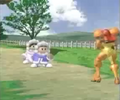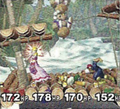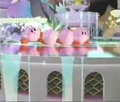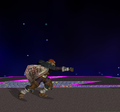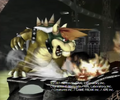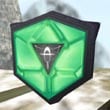Unused content (SSBM): Difference between revisions
m (Text replacement - "{{reflist}} [[" to "{{reflist}} [[") Tag: Mobile edit |
mNo edit summary |
||
| Line 115: | Line 115: | ||
BetaCostuming.PNG|Here all four players have the same [[alternate costume]], which is impossible in normal play. | BetaCostuming.PNG|Here all four players have the same [[alternate costume]], which is impossible in normal play. | ||
Hell Hawk.jpg|Captain Falcon with "Hell Hawk" emblem. | Hell Hawk.jpg|Captain Falcon with "Hell Hawk" emblem. | ||
Beta Falcon Punch | Beta Falcon Punch.gif|Falcon Punch with its speed from the original ''Super Smash Bros.'' as seen in the Special Movie. | ||
Jab 2.png|A screen capture of the second jab that Ganondorf would have had, which is a glitch. | Jab 2.png|A screen capture of the second jab that Ganondorf would have had, which is a glitch. | ||
Earlybowserfireanimation.png|Screen capture of an early animation of Bowser's Fire Breath neutral special, as seen in E3 2001 promotional material. | Earlybowserfireanimation.png|Screen capture of an early animation of Bowser's Fire Breath neutral special, as seen in E3 2001 promotional material. | ||
Revision as of 06:49, May 6, 2022
The following unused content is known from the development of Super Smash Bros. Melee.
Fighters
Considered
- A number of characters were intended to represent Nintendo's early NES era, a role that was ultimately fulfilled by the Ice Climbers. Among the other considered characters included Balloon Fighter, the player character from Urban Champion, Bubbles from Clu Clu Land, and an Excitebike racer.[1].
- Ayumi Tachibana from Famicom Detective Club was considered as a playable character, as confirmed by Sakurai on a Niconico interview in 2016. She was ultimately dropped as a candidate as Sakurai felt her series, more than any other in the game, would be wildly unfamiliar to international audiences.[2]
- Lucas, the protagonist of the then-unreleased Mother 3, was initially supposed to appear as a replacement to Ness. When Mother 3 was cancelled for a Nintendo 64 release and instead moved to the Game Boy Advance for development, Ness was kept in Melee. Lucas later became playable in Brawl, but did not replace Ness.
- Reportedly, Hideo Kojima, a close personal friend of Sakurai, asked him if Solid Snake from Metal Gear Solid could be considered as a playable character in Melee. One of the reasons why Kojima asked Sakurai is because his son wanted to see Snake in Smash[3]. By the time of Kojima's request, however, Melee was too far in development for the developers to feasibly add another character[4]. Snake later became playable in Brawl.
- Former head of Sonic Team, Yuji Naka, stated in an interview with EDGE magazine that Sonic was strongly considered for Melee, but was not added due to time constraints.[5] Sonic later became playable in Brawl, and he also became the basis of a famous hoax.
- Wario was strongly considered for Melee's roster, and on a fan questionnaire on Smabura-Ken, Sakurai stated that he would add Wario to Melee if he had more time to add just one more character.[6] Sakurai also explained that he had opted to instead allocate the team's limited development time to implementing other characters such as Mewtwo or Marth and Roy, and he also wanted to avoid having an excessive number of Mario characters.[7] Wario later became playable starting in Brawl.
Other characters
Masahiro Sakurai answered fan questions in a questionnaire on the original Super Smash Bros. website, with some of them regarding the inclusion and exclusion of particularly popular characters.
- Sakurai stated that Takamaru appearing in Super Smash Bros. was unlikely, as The Mysterious Murasame Castle had not received a new game in several years and that the game itself was rather obscure[8]. Takamaru later appeared as an Assist Trophy in Smash 4 and Ultimate, and music associated with his game is available in Brawl, Smash 4 and Ultimate.
- When asked about what character he would like to include in the next Super Smash Bros. game, Sakurai stated he wanted Mach Rider to be in the game, because he thought he had the "best name."[9]. He also stated that his generation usually wants characters from Mach Rider and The Mysterious Murasame Castle.[10]
- On the topic of characters owned by Rare, Sakurai stated that it would be difficult to include characters such as Banjo and Kazooie owing to copyright reasons.[11] While no Rare characters appeared in Melee, the Cloaking Device and Motion-Sensor Bomb, in Japan only, are based on their appearance in Rare's Perfect Dark. Banjo and Kazooie eventually made it into Ultimate as DLC fighters.
- Sakurai stated that he did not include James Bond from GoldenEye 007 owing to concerns over Bond's realistic weaponry that included handguns and similar items. Furthermore, the copyright to the game would be owned by Rare, and a number of other copyright issues, such as those involving the likeness of his actor, Pierce Brosnan, and rights involving the film series itself, would have led to numerous legal challenges in development of Melee[12]. While Bond himself has not appeared in the series, the Motion-Sensor Bomb's design in Melee is based off its appearance in GoldenEye 007 in the game's international release.
Sakurai's statements regarding James Bond, Banjo, and Kazooie have led to a misconception that they were actually considered for inclusion, but he never stated that they were in consideration, only that he did not include them owing to various difficulties.
NONE
A mysterious character named NONE can be accessed solely through the game’s debug menu, and crashes the game when attempting to start a match with it. NONE can be used in the results screen, however, where the nametag cycles through all of the characters before landing on Sheik, and then cycling through the team colors before showing NO CONTEST and crashing. NONE’s intended use is unknown, however it was most likely for debugging purposes.
Stages
The game initially had only 10 starter stages, one for each of the default character universes except for Ice Climber: Princess Peach's Castle, Kongo Jungle, Great Bay, Brinstar, Yoshi's Story, Fountain of Dreams, Corneria, Pokémon Stadium, Mute City, and Onett.
Differences
- Brinstar's acid seemingly dealt much more knockback, being able to KO Donkey Kong at 114%. The bottom blast zone seemed to be much higher, and the acid appeared closer to the platform before blocking the blast zone.
- Fountain of Dreams had a simpler layout with two stationary platforms on either side, similar to Pokémon Stadium's normal form.
- Fourside originally had ordinary black-and-white buildings instead of buildings with multi-colored lights, and the UFOs originally rotated and had a different design.
- Great Bay's laboratory on the main platform could be jumped on and walked inside of. In the final version, it is a part of the background, and players cannot interact with it in any capacity, though some remnants of the stage can be found by using an unrestricted camera hack. The platform at the right of the stage was also initially composed of three metal beams instead of five, to emulate its appearance in Majora's Mask. Additionally, a pot was present on the stage in debut gameplay footage.
- Green Greens had a darker color scheme, uneven drop-though platforms, stone Star Blocks and main platforms, and a maximum of four Star Blocks per row over both gaps instead of three. Whispy was also supposed to attack by blowing.
- Kongo Jungle was initially labelled as "Congo Jungle", retaining this trait from its original predecessor also featured in Melee. All final releases fixed the typo on both Melee and 64 variants of the stage.[13]
- Jungle Japes initially had some gray textures on the floor, as well as a slightly different background image.
- Mushroom Kingdom initially looked similar to the Mushroom Kingdom in the original Super Smash Bros., even including Warp Pipes that could be entered.[14]
- Onett played a considerably different arrangement of "Bein' Friends" from Mother, which lacked the Eight Melodies component of the final remix and instead was more patterned after the version of Bein' Friends on the Mother vocal soundtrack album.[15][16] The stage was also initially called "Eagle Land: Onett" instead of "Eagleland: Onett."
- Pokémon Stadium's earliest screenshots showed the screen in the background being blank, though it is possible the screen simply was not fully programmed. Later screenshots showed the screen displaying elemental icons resembling those from the Pokémon Trading Card Game. Similar to Smash 64's Saffron City, Venusaur and a number of other Pokémon were supposed to interact with the stage.
- Rainbow Cruise originally had considerably more clouds, a grayer sky, and a different ship design. No gameplay footage has been found of this early version of the stage.
- Temple had an elevator on the right side of the stage. Additionally, mysterious brown platforms appeared throughout the stage, though they can be seen in the "Special Movie" video found in the game's Data menu.
- Yoshi's Island was larger overall with more rows of Rotating Blocks and an added column of smaller-sized blocks. It also featured three Note Blocks over the middle of the chasm instead of three Rotating Blocks.
- Yoshi's Story initially featured a completely different design. The rightmost stage part was a plateau followed by a curved path up to another plateau and a walkoff blast zone. It also had various blue platforms that do not appear on most other shots or footage of the stage, indicating that they may have been moving platforms.[14]
- Early gameplay footage shows the Ice Climbers and Samus appearing to be fighting on a stage that appears to resemble either Mushroom Kingdom Adventure or the All-Star Rest Area, neither of which are accessible in the final game. This stage has a darker colored path than either, alongside a fence and considerably fewer trees. A slightly altered version can be seen in the final product's opening with Kirby briefly walking around in the area.
- An early version of Final Destination shows a more polygonal design, with three rectangular blocks seen floating beside the stage and a brighter color palette.
Scrapped
A number of stages still have leftover data in Melee, though they can only be accessed through use of the debug menu.
- AKANEIA was intended to be a Fire Emblem stage, named after the continent featured in Fire Emblem: Shadow Dragon and the Blade of Light and Fire Emblem: Mystery of the Emblem, both of which also starred Marth. This stage was going to feature dragons, mages, and even ballistae slinging stones at a castle[17], a concept that was later realised with Castle Siege. No hacks exist that allow players to start a match on AKANEIA.
- DUMMY consists of a black background with a lone invisible platform that can be made visible with the debug menu. Loading this stage via the debug menu without additional hacking crashes the game. DUMMY's purpose in the game, if any, is unknown.
- ICETOP and 10-2 are both identical stages that load Icicle Mountain without the music. ICETOP was intended to be a second Ice Climber stage[18], as all other starter universes feature two stages, and 10-2 was to be a second Ice Climber stage in Adventure Mode after 10-1, the internal name for the Ice Climbers stage in the Adventure Mode. Loading this stage via the debug menu without additional hacking crashes the game.
- TEST is assumed to be a stage used for testing various gameplay elements. It consists of a large, gray test stage with a number of different moving platforms, and a background depicting a photo of Caffé Verona in Palo Alto, California, an image commonly used in OpenGL testing. The song "Corneria" plays on this stage.
- TSEAK was intended to be Sheik's own Target Test, distinct from Zelda's. Remnants of the stage consist only of a single dark gray platform and three targets.
Considered
- A stage based on the Sprout Tower from Pokémon Gold & Silver was considered in the development of Melee. [19]
Gameplay
- In the gameplay and demos shown at E3 2001, the hitstun dealt seemed to be the same as in the previous Super Smash Bros., with a hitstun multiplier of 0.52. However, in the final game it was changed to 0.4, possibly due to the increased falling speed of each character making recovery too difficult with such a high level of hitstun.
- It may have been possible to up smash out of shield without using jump-cancelling.[20] Additionally, shields were much bigger and perhaps less susceptible to shield stabbing. This gives possible explanation for why Mr. Game & Watch's shield is so small compared to his body, as the shield sizes may have been haphazardly reduced in the final months of production.
- It is speculated that L-cancelling removed all landing lag from aerials, like in the previous Super Smash Bros., instead of reducing it by half.
- The instruction booklet had an image for the description for Stamina mode showing all four characters having over 150 HP of stamina, which cannot occur in normal gameplay. Players in a Stamina match always start with 150 HP, and this value cannot be edited without the use of a hacking device.
- Early screenshots show that damage percentage font remained white instead of reddening and eventually blackening with climbing percentages.
- In the E3 reveal trailer, an early, less exaggerated version of Mario's neutral special animation can be seen.
- In E3 promotional material, an early version of Bowser's neutral special, Fire Breath, can be seen with an unfinished animation for his hair.
- The Special Movie shows characters in gameplay with several sound differences.
- In one clip, Mario yells a "Kiai" upon picking up a Hammer, but in the final game, none of the characters vocalize when they pick up the hammer.
- In Bowser's vignette, Peach yells "Yahoo!" while throwing a vegetable at him, which does not occur in normal gameplay. During the ending clips showing all the characters, Peach's clip features her taunting, with her saying "All right!" instead of "Sweet!" The voice actor in these voice clips also sounds slightly deeper than Peach's voice actor in the final game, Jen Taylor, suggesting that Peach's voice actress for Super Mario 64 and Mario Kart 64, Leslie Swan, was initially supposed to reprise her role as Peach in Melee. However, Peach's own vignette features her voice clips from the final game, provided by Jen Taylor, making it unclear when the switch was made.
- Pikachu was initially silent while charging Skull Bash.
- An unused shout from Popo while performing Blizzard can be heard during the ending montage. That unused sound was deleted before the game was ever launched.
- Early screenshots, footage, and the Special Movie show that characters, if selected by more than one player, could use the same alternate costume. Unlike in Team Battle, however, there was no change in contrast. This also assumed to be purposefully done using debug mode to film the Special Movie.
- Captain Falcon's Blood Falcon alternate costume originally had "Hell Hawk," the Japanese name of Blood Falcon's vehicle, written below the Blood Falcon emblem on its back.
- The Special Movie shows certain differences in characters' moves.
- Captain Falcon's Falcon Punch is seen to be as fast as it was in Super Smash Bros., and his taunt was initially not animated as smoothly.
- Kirby's Vulcan Jab combo did not feature small projectiles in front of his hands.
- Link's Bow did not glow upon being fully charged.[21]
- Donkey Kong gradually descended while performing Spinning Kong in the air instead of gaining some altitude.[14]
- The first shot in a series of rapid shots from Fox's Blaster dealt hitstun in addition to damage, instead of only dealing damage like the rest of the shots. Fire Fox seemed to cover a shorter distance. His Reflector could seemingly be landcancelled like in the original Super Smash Bros.,[22] but it is unknown if this means that it could not be jump cancelled as well.
- KOing a Goomba in the Adventure Mode caused a screen shake effect.
- Ganondorf, in version 1.0 of Melee, has an animation that can be found by using the Bunny Hood item, where it seems like he has a second jab. This jab attack can be accessed by a glitch and seemed to indicate that he was to have a jab similar to Falcon, but it was scrapped for unknown reasons.
- Master Hand and Crazy Hand were intended to have a grab team attack that would have been activated by pressing Y← while playing as Crazy Hand and Y↑ as Master Hand. In the final game, the attack is disabled. Viewing the subaction data reveals the attack is incomplete, as Crazy Hand has no hitboxes for the attack. [23]
Here all four players have the same alternate costume, which is impossible in normal play.
Items
- The Proximity Mine from Perfect Dark replaced the Motion-Sensor Bomb item from GoldenEye 007, though the original Proximity Mine was ultimately kept in the Japanese version of the game.
- The Pokémon Ditto was supposed to appear from Poké Balls. It can still spawn through use of the debug menu, but when summoned, it simply says "Mon-mon!", after its Japanese name "Metamon", spins while stretching vertically, then disappears, with its spinning animation inflicting weak damage and knockback to players. Ditto was still mentioned in the game's official strategy guide, stating that "Ditto will Transform into the player who threw the Poké Ball, then join up with him or her for a short time."[24] This suggests that Ditto was perhaps a late cut to Melee. Ditto itself makes a cameo in the game's Tournament Mode, acting as a graphic for Random characters. Ditto would later be incorporated to the roster of summonable Pokémon in Ultimate, with the exact same function it was intended to have in Melee.
- The Poké Ball Pokémon Electrode originally did not darken before using Explosion.
- Summoning items analogous to Poké Balls called "Assist Capsules" were planned for Melee but were dropped, later appearing in Brawl as Assist Trophies.[25]
- For a brief time, information relating to Sukapon from Joy Mech Fight was accidentally posted on the Japanese website. Sakurai later mentioned that Sukapon was originally going to be an item that characters could ride on, but was cut due to "adult matters".[26] Sukapon later became an Assist Trophy in Ultimate.
- The Timed Mine from GoldenEye 007 was originally going to appear in the game. It was likely scrapped due to licensing issues, or its close visual similarity with the Motion-Sensor Bomb.[27]
- "ItemBlind" is a unique animation for every character which can be found within the game's data. Each animation puts the character in a stunned or blinded state, aimlessly reaching out. It is a speculated to correspond to a cut item from the game.[28]
Menus
- Certain menu selections, specifically the Trophies, Options, and Data selections in the Main Menu (then-called "Top Menu"), as well as the Special Melee selection in the Vs. Mode menu, were all blanked out with "?"s. Furthermore, the panel to the right of the menus previewing the menu of the currently selected menu selection, looked considerably different.
- The Lottery interface had a radically different design, with the actual machine being considerably larger and featuring a model ship, roulette wheel and craps table in the background.
- The earliest character select screens aligned the character portraits to one side. Each of these screens featured less than 14 character portraits. Additionally, similar to the original Super Smash Bros. beta character select screen, the words "Battle Royal" were displayed in the top left corner instead of "Melee." Finally, the "Press Start" banner on the "Ready to Fight!" band was not located on the banner and instead just above the player boxes.
- Upon entering the character select screen, a short animation was originally intended to play, showing the icons for clone characters coming from behind the character they are based on.
- Later versions of the character select screen close to the game's release looked nearly identical to the final product. One image on the Japanese website shows Zelda's character portrait covered by a "?" mark, like other secret characters. As Sheik's playability was revealed before Zelda's, the move is speculated to avoid spoiling the surprise of Zelda's playability. This screenshot also shows that the Ice Climbers' Japanese name was hyphenated.
- The stage select was formatted differently, with Brinstar placed on a top row and Corneria being in the middle. "?" portraits were also in place of presumably the two Special Stages and three Past Stages.
- All-Star Mode was intended to have intro screens nearly identical to the ones found in Classic Mode. They were ultimately unused, with the mode ultimately using the All-Star Rest Area in transitions between fights. These intros can be viewed in the debug menu, and it is notably the only way players can see the unused intro images for Ganondorf, Sheik, and Roy[29].
- The earliest Classic Mode intros also looked vastly different from the final version's, featuring different character artwork and no maps or backgrounds. However, Bowser's Classic Mode render remained the same but was positioned more towards the background, and so appeared slightly smaller.
- The Game Over screen has a leftover "YES" action in the code which this option does nothing if the player has low coinage leaving no choice to quit the session and have to start over. It was likely to be done when this game was released as a coin-op arcade game.
- The game reveals to have unused animations leftover, called "Selected" and "SelectedWait". The names of these animations, along with the video, reveal they were intended to play upon selecting a character, akin to the original Super Smash Bros.
An early version of the Lottery interface.
Trophies
- Six trophies were fully rigged if viewed in Maya. It's possible that the rigs were not deleted by accident.
- More Fire Emblem trophies were planned to be included in the game, but they ultimately proved too complex to make compared to other trophies[30]. In the final game, the only two Fire Emblem trophies are those for Marth and Roy after completing Classic Mode with either character.
- Trophies from games by Rare Ltd. were planned to be included in the game, but they were later dropped due to issues contacting Rare, according to a Nintendo Dream interview with Sakurai[31][32]. Trophies from third-party vendors later appeared in Smash 4.
Bonuses
Some Bonuses were left out of the final game, though they can be accessed with an Action Replay. The reason for their removal is unknown.
| Name | Points Given | Requirement |
|---|---|---|
| Barrel Blast KO | x300 | Used a Barrel to KO someone. |
| Crash & Burn | -500 | All Meteor Attacks Missed. |
| Deflector | 1000 | Unknown (presumed to be something to do with reflecting attacks) |
| Green Shell Shooter | x800 | Caused damage twice or more with a Green Shell. |
| Poolshark | x300 | Threw one enemy into another. |
| Red Shell Shooter | x400 | Caused damage 3 or more times with a Red Shell. |
| Ricochet Rifler | x800 | Deflected shot hit an enemy. |
Sounds
- Captain Falcon has unused audio files called SFXV_CAPTAIN_BLUEF which is him saying "Blue Falcon!" and SFXV_CAPTAIN_COMEON which is him saying "Come on!" . Both audio files would be later used in the next game for his Final Smash.
- Both Dr. Mario and Luigi have unused leftover audio for Mario's Taunt sound effects.
- Marth has an additional phrase that goes unused: "レッツダンス!" "Rettsu dansu!", the English phrase "Let's Dance!" approximated phonetically in Japanese.
- Zelda has an unused audio files called SFXV_ZS_ZELDA_FIRE which is alternate take for Din's Fire and SFXV_ZS_ZELDA_N_AI which is likely an audio file for Nayru's Love since Ai (愛) means love in Japanese.
- Ganondorf has unused audio file called SFXV_GANON_KIRIFUDA which would later be used in the next game as his Wii Remote selection sound
- "Kirifuda" (Japanese: 切り札 or 切札) means a "trump card" or "last resort" in Japanese, strongly suggesting that Final Smashes were also planned in Melee, whose Japanese name, Saigo no Kiri Fuda (最後の切りふだ), translates to Final Trump Card.
- Both Pikachu and Pichu have an unused audio file called SFXV_PIKACHU_SUTEMI and SFXV_PICHU_SUTEMI respectively.
Music
An unused version of the music on the Temple stage features different instrumentation, using Ocarina of Time-esque music sounds.[33]
Early version of the music on Temple.
Box art
The original boxart depicted an in-game screenshot of Mario getting attacked by Bowser with his Fire Breath instead of showing Mario, Bowser, Link, and Pikachu fighting. The lighting on Hyrule Temple was also considerably brighter. While unused for the final game, this box art was used for some of the game's early promotional material, such as websites accepting orders for the game, a Nintendo employee lanyard at events[34], and some print advertisements and retail catalogs.
See also
- Unused content
- Unused content (SSB)
- Unused content (SSBB)
- Unused content (SSB4)
- Unused content (SSBU)
References
- ^ http://www.nintendo.co.jp/n01/n64/software/nus_p_nalj/smash/flash/1009/index.html
- ^ https://www.youtube.com/watch?v=x4HvNnUaH08&feature=youtu.be&t=4557
- ^ https://twitter.com/PushDustIn/status/1350186268542566402/photo/1
- ^ http://www.n-sider.com/contentview.php?contentid=2576
- ^ https://www.youtube.com/watch?v=jK1Kp679FGc&feature=youtu.be&t=1899
- ^ http://www.nintendo.co.jp/n01/n64/software/nus_p_nalj/smash/flash/syukeiken/return512.html
- ^ [1]
- ^ https://www.nintendo.co.jp/n01/n64/software/nus_p_nalj/smash/PostReturn025.html
- ^ https://www.nintendo.co.jp/n01/n64/software/nus_p_nalj/smash/PostReturn049.html
- ^ https://www.nintendo.co.jp/n01/n64/software/nus_p_nalj/smash/PostReturn003.html
- ^ http://www.nintendo.co.jp/n01/n64/software/nus_p_nalj/smash/flash/syukeiken/return506.html
- ^ http://www.nintendo.co.jp/n01/n64/software/nus_p_nalj/smash/flash/syukeiken/return526.html
- ^ http://www.ign.com/articles/2001/06/16/inside-super-smash-bros-melee-part-iii-gamecube?page=5
- ^ a b c https://www.youtube.com/watch?v=9exe4q9ykaQ
- ^ https://www.youtube.com/watch?v=FYoZLTKoAlM&feature=youtu.be&t=697
- ^ https://www.youtube.com/watch?v=vAqq019dOpg
- ^ https://www.nintendo.co.jp/n01/n64/software/nus_p_nalj/smash/flash/syukeiken/return527.html
- ^ http://www.nintendo.co.jp/n01/n64/software/nus_p_nalj/smash/flash/syukeiken/return554.html
- ^ http://www.nintendo.co.jp/n01/n64/software/nus_p_nalj/smash/flash/syukeiken/return520.html
- ^ https://youtu.be/RK-RqQTEppw?t=7m36s
- ^ http://www.nintendo.co.jp/ngc/galj/movie/galj_ml1.wmv
- ^ https://youtu.be/RK-RqQTEppw?t=6m43s
- ^ https://youtu.be/A9QaJn0oTIU
- ^ http://www.sourcegaming.info/2015/04/13/the-definitive-unused-fighters-list-in-smash/#%5BMelee%5D
- ^ https://www.nintendo.co.jp/n01/n64/software/nus_p_nalj/smash/flash/syukeiken/return537.html
- ^ http://www.nintendo.co.jp/n01/n64/software/nus_p_nalj/smash/flash/syukeiken/return510.html
- ^ https://www.youtube.com/watch?v=x2zZoAqEbXY
- ^ https://www.youtube.com/watch?v=RySzY21Oenk
- ^ https://www.youtube.com/watch?v=NGOzsSEBO9Y
- ^ http://www.nintendo.co.jp/n01/n64/software/nus_p_nalj/smash/flash/syukeiken/return569.html
- ^ https://twitter.com/PushDustIn/status/1138759804208291841
- ^ http://nintendoeverything.com/rare-not-upset-that-nintendo-didnt-request-conker-banjo-in-smash-bros
- ^ https://www.nintendo.co.jp/n01/n64/software/nus_p_nalj/smash/flash/0118/kokaon.html
- ^ https://twitter.com/davidvkimball/status/1352339240256851968
External links
- Elevated: the Development Story of Super Smash Bros. Melee - documentary about Melee's conception, development, and release.






















